|
On a recent walk-about Happy Valley with David Brett we made this Dandelion line on a rock in the potential site our our last scene We had technical problem with our last Devising Session on zoom because we couldn’t open the breakout rooms so couldn’t meet in smaller groups. People are naturally less reluctant to speak in larger groups; its not easy in any event because zoom has this small delay and people occasionally speak over each other as a result. However we managed with zoom as we always do. The devising group have been amazing, patient, imaginative and loyal, and new people joining, which is great. So here are the notes from the Music and Verse delving session and the provocation for the next one. Over the next four devising sessions we will be developing the plots of each our our four stories and discovering how to tie them together in a final scene. PROVOCATION FOR DEVISING - THE STRUCTURE OF THE PLAY
& DISCOVERING THE PLOT'STAYING HOME' The title of this session may sound daunting but we have actually reached a very creative stage of developing the play. We are getting down to finding the plot of each of our four stories. 'Staying Home' 'Leaving Home' 'Displaced' and "Coming Home'. All through the devising process I have tried to accommodate all the ideas and find a pattern, look for ideas that recur, maybe in different ways but essentially have the same theme. For example Evacuees, Refugees, places of refuge, have all come up; as have pilgrimages, journeys, life's paths, the landscape paths of Happy Valley themselves, the purposes of journeys to and from Home, community, sanctuary, safety. Home is our subject, our four stories have themes that reflect Home. Now each of those stories need to be defined and crested as scenes; then we will discover the relationship between those stories to form a concluding scene that ties it all together. The scenes we discover over the coming four fortnightly Wednesdays will be explored on the two intervening Mondays with the improvisation group, and we will report back at the Devising Session. Everyone in the devising group is invited to come and observe the improvisations every second Monday so you can give us your feedback. The improvisers will improvise scenes so that the devises don't have to - but they are, of course, welcome too if they wish. I will start the next devising session talking about possible structures for the whole play, how we might frame and link stories. I will expand on that on Claque's website (click below) After that The first story we will look at is "Staying Home.' The following sessions we will look at two stories each time. NOTES ON DEVISING 28TH APRIL MUSIC & VERSE Becca's, Gilly's and David (our Musical Director's) notes from our Music/Sound Workshop on 28th April. PRESENT; Amy Church, Scott Kingsnorth, Jill Scott, Claire Edwards and Daniel, Paul Fulton, Kate Sargent, Phil Byrne, Sally Sugg, Gilly Blaydon, Mary Jane Stevens, Joe Mendall, Lucy Edkins, Alison Mackenzie, Sonia and Michael Lawrence, Bernie and Julie Madden, David Brett, Jon Oram, Becca Maher. There were problems with zoom so it wasn't possible to go into break out rooms as we had planned. David Jinks wasn't able to join us due to those technical issues. We welcomed Amy who had joined the devising for the first time. She said that at her college she had taken part in a devised piece about homelessness. Song is a good way to tell a story and creating an atmosphere. A song can speak a thousand words. Initially we'll be gathering in the field opposite the church . Not yet decided whether music will be used at that point. What instruments would we like to hear/play? The natural environment such as sticks/rocks/grass make sounds. There will also be other ambient sounds such as dogs barking, people walking/talking. At the large oak tree the four paths diverge: place for poem “The Road Not Taken” Robert Frost. Invisible siren voices luring audience down the different paths. Bells in trees. There’s a branch of the “screaming tree” that swings by itself for a long time – put bells on that. Rocks as instruments. Use the landscape.Daniel: Is a campanologist. Wondered if we could use whatever bells they had in the church. (Later discovered they have one bell.) David has a set of 8 handbells. Bells could be timers to indicate when a group needs to move on. We could add humming to bell ringing. Humming in caves, echoes. Humming might be safer than singing due to covid. Humming is very atmospheric. M.J. Dinner gong, or J. Arthur Rank type gong – can be heard over whole area. She has a djembe ,rain sticks and other percussion instruments and would like to sing too. In Midsummer Night's Dream, Peter Brook used long tubes whirled around the head, like bull roarers. Sally has written a poem about a soldier returning home with combat stress. Sonia has also written two poems on the subject of home which she read to us. Poems condense as do songs. Song "Keep the home fires burning". Home sickness, recognition/tribal music. Small drums to beat a pathway. Military style. Phil can play snare drums. David has drums and other percussion. Involve the Syrian refugees in Tunbridge Wells (T.W Welcomes Refugees). There are Syrian musicians in T.W. They would not need to attend every performance. We could make it clear that singers/musicians would be welcome even if they couldn't attend every performance. We could use a fallen tree as a boat carrying refugees. Alison spoke about a play she saw where the mobile phone was the most important object as the traffickers were going to abandon the migrants at a certain point and they would have to use thir phones to call the coastguard to rescue them. The phone was literally their life line. We could use phones to create sounds. Bath house could have Regency music, or modern songs arranged in Regency style (“Splish Splash”?). Singing in the bath. Voyeurism, audience creeping up to view. Not making any sound can bring tension. Contact singers we know who might be interested. David has mentioned this to a couple of singer contacts who are interested. Paul mentioned a friend who is an opera singer. Familiarity/ recognition is good. But singing songs that are too familiar or obvious might sound a bit too much like busking. Has to be a bit strange and unfamiliar to draw you in. Calling from rock to rock, like a beacon. Street calls. Call and response. We should try one evening with a group, calling across the space to test the acoustics. A performer whispering a poem into your ear.Songs should be simple: chorus, refrain, repetitive. Each story could have a musical theme which is woven into a larger musical piece at the end.Just as the thread of each story is woven into the final story.Involve the Create Choir if possible. Use of phones as backing for songs. wireless speakers which could be used to play music or sound at a distance.Could be used to play birdsong in trees. Amplify the sound of shuffling feet, crunching through leaves and twigs. Or an image first seen as something normal changes to something strange. Image of the Displacement group wearing headphones. Actors listening to headphones , choreographed dance movement to unheard music. Emphasising they are cut off from their environment. Staying home we don't always notice or appreciate where we live. If Happy Valley is the star of the show maybe we shouldn't use too much technology. We want to enhance the features of Happy Valley and use what we find there. All the stories are really about Staying Home. All drama is about this. People don’t take enough notice of their surroundings. MAIN POINTS; 1) We will continue to make Land Art/sculptures throughout the summer.There will be more dates for workshops that will be opened up to a wider audience. 2) Musicians/singers we could involve. David has a friend who is an opera singer and is happy to take part. Maybe contact TW welcomes Refugees regarding Syrian Band. Do we have any friends/contacts who are musicians/singers. Amy, Julie, MJ, Alison, Jill and Bec are happy to sing (but not all happy to sing solo), Jill can play the recorder and Phil drums. 3) Organise music/sound workshops, looking at how sound/music travels in Happy Valley, in caves near rocks etc. 4) Consider songs that relate to the theme of home. 5) Next Devising Workshop Wednesday 12th May 7.30 p.m. Devising Group will be invited fortnightly to join zoom improvisation sessions from Monday 17th May at 7.30 pm.
0 Comments
THE STRANGER ON THE PATH 24th February session PROVOCATION ON STRANGERS ON THE PATH On our next Wednesday session is going to ask you to imagine that you are walking in Happy Valley and sit on a bench to look at the view over High Rocks and Hargate woods. A stranger sits down beside you and you start a conversation and his or her story grows and develops as you ask questions. This is the setting of a game between you, the curious questioner, and a seasoned improviser. The first part of the evening we will disperse as usual into break out rooms. Two or three people plus one of the members Claqueur impro theatre. You will simply ask them questions to delve into the life of a stranger. Neither you nor the improviser will know where the story they tell will go. The story will be prompted by the questions you ask. Questions will encourage the storyteller to dig deeper into the story. When it’s over we will return to the main group where you can share the stories you have been told. PLEASE BRING PAPER AND COLOURED PENS AND DOODLE AS YOU HEAR THE STORIES. You don’t have to share them though it’s nice if you do. But drawing prompts your visual memory of the story. This is not an art competition its part of a process of stirring our imaginations, just give it a try. DEVISING SESSION NOTES ON STRANGER ON THE PATH PRESENT; Joe Mendel, Michael and Sonia Lawrence, Paul Fulton, Claire Edwards, David Jinks, Jill Scott, Kate Sargent, Richard Sylvester, Sally Sugg, Gilly Blaydon, David Brett, Julie and Bernie Madden, MJ Stevens, Alison Mackenzie, Lucy Edkins, Becca Maher, Jon Oram. Jon talked about the idea of audience members being given a letter and on their journey they will meet a stranger (cast member). The audience will need to find out as much as they can about the stranger’s story, by asking them questions. The stranger may have nothing prepared and the questions will prompt a story. We were then placed in break out rooms with members of the improvisation performance group acting as the stranger. Jon did a practice run with MJ, Joe and David Jinks as audience members. Jon(stranger) was a father looking for his son. His son had left home many years ago and until he had had a letter fairly recently there had been no contact. Jon carried the letter from his son (each stranger might have another object such as a key, a cup that would have significance). The letter was sent from The Happy Valley area. The stranger didn’t know why his son had run away from home when he was 13. Group 1. Richard, Bernie, Becca, Alison. Richard (stranger) had come to Happy Valley looking for gold. A friend had told him there was gold in the rock or in the water. He needs money to claim the love of his life, Esme. Esme’s father gave him 5 years to make his fortune so that he could look after Esme and would therefore be a suitable husband. Since then, he has been working hard having many jobs including looking after pigs. He now only has a few days before the 5 years is up so is relying on finding the gold in order to marry Esme. Esme’s father owns a pub, The Walnut Tree, near to Happy Valley. . Not many people know about the pub as its tiny. The stranger is not allowed to work there to earn money as he has been in prison for arson. The stranger revealed that he has not told Esme or her father about his criminal record so some of the audience became concerned for Esme and wondering whether the stranger was after all a suitable suitor. Group 2. Paul, Lucy, Julie Paul (The stranger) was very sad about the loss of his wife, Edith. He had met her when he was a DJ on a cruise. He had a dog called Wolf. The stranger had found a half written letter (from Jon’s son, reincorporation). Audience felt that maybe they should pop in and see the stranger as he was lonely. Group 3. Jill, Gilly, Kate, David Jinks. Kate (stranger) was a painter seeking inspiration. They pretended they were in an art class to enable them to look at the stranger’s painting. She lacked confidence; how could we make her famous? Maybe she could do a series of pictures. Gilly and Jill started drawing. It felt a bit like communal Art Therapy. Group 4. David Brett, Joe, Michael and Sonia. David (Stranger) was looking for his 3 friends. They had made a pact 50 years ago that they would meet now in Happy Valley. He had travelled from Australia on a steamship. He had broken his son’s arm so maybe he isn’t a very nice man? Maybe he was the problem rather than the rest of the family as he claimed? The bad apple in the barrel? They discovered that he and they were wearing kangaroo skin boots. Group 5. Sally, Jon, MJ. Claire
Jon (Stranger). The stranger’s name was George who told a sad story. Thirty years ago, his father killed himself. In one of the rocks there’s a carving of the Frog Brothers Music Group, which his dad was a member of. George was anxious as his dad had buried a lot of money in a tin. However, he told George he wanted him to make his own way and then reveals that he has hidden treasure in Happy Valley and shortly afterwards kills himself. George has worked hard for 30 years as a butcher but has never found his way. He felt he was a disappointment to his father, and he is now the same age as his father was when he died. Something has motivated him to disclose to us, is he suicidal? I feel bad that I let him walk away. Jon Postscript The questioning of an improvisor Actor validated the idea that we could have improvised elements the involve the audience. We might need to think about how we set up the situation or brief the audience to find out all they can from the 'stranger' character. If we are to take the audience on a journey we next need to think about what roles they might play, whether they have a task, a mission, or a purpose for this journey. DEVISING HAPPY HIGHWAYS
February 10th 2021 Theme: "Stories" Present: Participants: Claire Edwards, Gilly Blaydon, Gill Scott, Lucy Edkins, Kate Sargent, Paul Fulton, David Brett, Michael and Sonia Lawrence, Richard Sylvester, Julie and Bernie Madden, Phil Byrne, Suzy Phillips, Alison Mackenzie, Jon Oram, Becca Maher. NOTES ON DEVISING SESSION "STORIES" Jon talked about reaching out perhaps further than the play to different groups in the village by sharing stories and perhaps displaying them at shop counters, shop windows, delivering fliers getting stories into Rusthall Life etc. Suzie talked about the quirky tree they had at the RCA festival in 2017 people hung items and poems. Sonia spoke of a man called Arthur Tribe who lived at 15 Rusthall Road and died in 1961 aged 90. He had lived in the village all of his life and he loved the common. There is one particularly moving poem written when he was posted in North Africa during the First World War where he described memories of Happy Valley keeping him going. Sonia has since sent in the poem about Happy Valley. Jon introduced the purpose of the session buy talking about the power and purpose of stories, why where and when do people tell stories? What situations encourage story telly? How might we deliver stories in the play; What situations can we set or recreate, from bedtime stories to Speakers Corner? Jon mentioned the communal bath is potentially where people would tell stories to each other. People would come here for health reasons, not unlike pilgrims to Lourdes. Michael had set some atmospheric picture of the baths. He sent another this week building on the idea of it being a story telling station. Sonia said that her son had excavated the baths several years ago down to the tiles, it wasn’t very big. They then filled it in again. GROUP 1 Bec, Suzie, Julie Grandparents passing down stories, sitting on laps. Imaginary friends. Folk tales, songs, rounds, ghost stories, stories around the fire; bonfires elicit story-telling and singing. There’s reminiscing, night and fire, sounds, smells. Morale tales, Victorian Struwel Peter, Johnny-Head -In - Air didn’t look where he was going so walked over a cliff. Matilda and the matches if you cry wolf (Matlida gets burnt to death). Grimm’s Fairy Tales, The Grimm brothers travelled all over Germany to collect and preserve traditional tales. Fairy stories portrayed females in a particular way ie: goodness and beauty go together, Cinderella and the ugly sisters, she will be rescued by a knight in shining armour. Giving messages to girls on how they ought to be, conditioning women, propaganda. Greek myths and legends, The Odyssey, men are heroes. GROUP 2 Lucy, Gill, Sally When, Where Why? WHEN: bedtime stories, one on one, comforting, fiction and real life memories. Around a table; eating, drinking, Bonfire; stories through song, walking with a friend through lockdown meaningful conversations. WHY: Sharing memories, making sense of our past, connecting, sharing, bonding. Draw from memories. Draw inspiration from emotions, does it have to have structure? Can be spontaneous don’t have to go anywhere. Story cubes, pieces of paper with prompts. WHAT makes a story? It has to have emotional content. GROUP 3 Kate, Gilly Bernie We tell stories when we have time. More time in lockdown. When travelling, train journeys, exchanging stories, getting to know people. Confession in crisis, truth. Lies/showing off. Telling untruths. Fake news, political narratives. Unintended consequences of stories. Families have different stories/different versions of events. Excluding and including information. GROUP 4 Alison, David, Michael, Sonia Dark winter nights, passing on stories, campfires, bringing people together. Sharing stories. Pubs, the more you drink the more outrageous. Sailors yarns, soldier’s self-glorification, heroism. Children want the same story over and over again. Familiarity is safe. Stories of your past become more important as you age, Stories keep people alive who are no longer here. Super- heroes used to be Gods now they’re Spider man, Superman. Folk stories, fairy stories, children want frightening stories. Eastenders/Archers/Shakespeare. Does it have to resolve? There are a limited number of basic stories. GROUP 5 Paul, Claire, Richard, Jon Stories inspired by College/family reunions. Stories develop into gossip. Future stories, fortune tellers. Churches/religion hopes and fears for future. Folk songs, letter writing. Dog walkers exchange stories about their dogs. First dates, interviews, interrogations. Hospital beds. GENERAL DISCUSSION. Invisible Theatre – rehearsed / improvised scenarios happen spontaneously on trains, busses in the street; the audience don’t know it’s been prepared. Alison/ Belgian refugees Mayor and mayoress from a village outside Antwerp came to Tunbridge Wells with their extended family in 1914. They lived in Nevill Park and decided to come here as she liked Thackeray. They walked in Happy Valley. Both died in 2015 and there was a huge funeral as they were so well respected. Looking at ancestry, who do you think you are? Reciting in military costume? Phil talked was asked about Chimney Sweeps, they supposed to be good luck at weddings. Story is that King George was on his way to a wedding when one of his horses got spooked and a chimney sweep saved his life so they became a lucky symbol. The Queen and Prince Philip had a chimney sweep at their wedding. The idea of story cubes was put forward. Jon wondered about situations when we would be less likely to tell stories – short bus and train rides, in an elevator, just approaching someone in the street – this would feel weird. Situations that encourage stories – interviews, interrogations, First Dates, `Gossip and Chinese whispers, telling tales out of school (splitting). Somebody mentioned imaginary friends. The idea of Travelling theatre groups was added to the mix. PROVOCATION ABOUT JOURNEY’S What kind of journeys do people make and why do they take them? Physical journeys of necessity, pleasure, or work, adventure or escape. Think of the t journeys in literature; Canterbury Tales, a Kentish pilgrimage where fellow travellers shared stories; Pilgrims Progress, a journey from this world to that world which is to come. The Wizard of Oz, where Dorothy follows the yellow brick road to both find her way home and save Oz from the wicked witch, and on route picks up fellow travellers who help her, but have personal missions of their own, one to gain a heart, another a brain and a third to find courage. The Hobbit, a chosen band on a quest to win a share of treasure guarded by a fearsome dragon. Or think of real, local characters who are likely to have once walked through Happy Valley; would we like to meet our ancestors and hear stories from our own community? Imagine an audience, not merely witnessing a story being played out before them, but actually taken on a journey, fellow travellers with the actors. Might they collectively be set a task, or have personal missions of their own, what might they discover, what and who might they meet on the way? what paths do they travel, do they have choices about which route to take? How do we go about creating a real adventure for them? Imagine an audience divided into different travelling groups, will they be given a guide, or discover cast members as travellers as they set out? Will each group or indeed individual experience a different journey or story to the others? Where will the journey end? In Happy Valley there are many potential performance areas, where scenes can happen, events and rituals can take place, story circles can be created. Most notably there is a large natural amphitheatre. Could this be where the final part of the story is told, and what would that be? Maybe it's the journey's end, if so, where could that be? This conversation is about gathering ideas that reveal how this unusual performance style might work, how we can both tell a story and involve the audience in the adventure. Could it be that the final outcome in not known to anyone, not even the cast? DEVISING SESSION NOTES ON "JOURNEYS"
Present; Michael and Sonia Lawrence, John Harris, Paul Fulton, Gilly Blaydon, Gill Scott, David Brett, Richard Sylvester, Alison Mackenzie, Julie and Bernie Madden, Sally Sugg, Kate Sargent, MaryJane, Jeremy Woodruff, Jon Oram, Becca Maher. Mark Broad registered his interest but had to leave. David talked about Nana Tomova a Sussex based storyteller. She is a qualified guide and professional storyteller who takes people across the Sussex Downs to tell her stories. Jon suggested play where the audience could be travellers be implicated in the drama. He reminded us that we will have to be flexible in the mechanics of the show because of COVID restrictions. Rather than thinking this as a restriction, perhaps it’s an opportunity to create a theatre experience that engages the audience into conversation, and physical engagement. There are connections with first world war Belgians refugees in Happy Valley. Also, the Beacon pub housed Jewish refugee children during the second world war. Different destinations, rushing. Encounter images/events on way, Exhibitions in a suitcase. Problem pictures. Tableaux. Refugees take them on a journey. Audience as refugees- stories told to each other. Maybe 3 groups encounter different scenes different strands of a story. Referred to Kentwell House in Suffolk as potential style – an area of re-enactment, crafts people – a living community in the valley. Canterbury Tales, encounter Inns on your travels, Sweeps cave? Fox hunting took place in Happy Valley audience hide the fox. The idea of suicide as there are places from where you can jump – audience engaged in persuasion (talking them down) Reference to “wonderful walks” an article Alison discovered. In the 1890’s there were geological walks, extraordinary descriptive language. In 1975 Rusthall primary school undertook a project called Wonderful walks where they walked around Happy Valley and wrote about it. Flash mob implicating audience actors not in costume. Audience given a letter to deliver (refrences to Claque Mystery Houses where single audience member is engaged in one-minute theatre experience, where they make decisions. Sweeps cage possible refreshment area, An actor/ guide leading people through different experiences, meeting at a central point, experience of place/geography. Audience having independent choices of which paths to take Go down one path you receive a reward, or a negative experience (out of tune violin?). Meeting figures from history, journeys happy and sad. Searching: “Where is Home” Caves/carvings/sacrifice/mythical energy about the rocks. Graffiti- loves lost/loves found. Murder most foul. Supernatural area -Owls in trees, themed areas; people in the trees. Land art in the trees. Paths not taken. Do you involve audience. Actors not learning lines, but improvised characters. Story stations, leader/guide/character. Chest of drawers with ancestral belongings, claimed by characters. The film The Point, starring Wayne Sleep. His character was ostracised and teased. He went on a journey and discovered everyone has a point. An outer and inner journey, bringing all stories together at the end. Responding to environment. Boarding houses. Moved to Pantiles. William Cobbett. Actors question audience, “why are you travelling?”. A quest, letter in envelope. Jon described his life changing experience of a little girl during a community play taking his hand and asking why a child in the play was being hanged for stealing bread as he was hungry. How those moments of reaching across the centuries to others like us can be so powerful for example a Jewish refugee child at The Beacon. Where is home? John Harries knows Peter Cornwell the owner of The Beacon. His son runs a theatre company. They have an amphitheatre in the grounds of The Beacon. The 101 steps down to the cold baths lead to a No Entry sign. Could we use masks (might be necessary anyway re: COVID). Land Art, Field, Forest and Sky on iPlayer. SUMMARY: These notes reflect the meeting as one idea stimulated another so are written in the order or form in which ideas flowed. They can act as stimulus for developing the form of the performance; also a provocation to develop of discover new ideas. Overall, it seems that there is a feeling for hearing, seeing, witnessing, participating in a collection of stories which come together at the end so there is a sense of unity, a final event that connects all the stories or lives we’ve heard on the journey. JANUARY 14th Legend II HAPPY HIGHWAYS DEVISING SESSION |
| WHAT WE DISCOVERED The Stone People - Birth NB. The Stone people being born from the earth is based on an Inuit myth This has led us to think: Stone people are born as stone and over time become flesh. Theatrically that’s full mask to half masks, to forehead and nose or chin masks. The stone people have to go to ‘birthing places’ (areas of exposed rock) to find their children. Stone people can be born in rivers and oceans when they will reawaken as water creatures. Sometimes they will be dug out trees that grow out of the rocks. Toad Rock is a sacred ‘birth place’. Women are obliged to dig for babies, “they’re waiting for us”. Their mothers are destined to find them; they know their own baby. Families might consult ‘Finders’ who sense where the mother should dig for her child; children and parents are destined to find each other. When they Stone people die they become stone and return to the earth retaining their knowledge and memory of past lives. When the woman digs for a baby she might accidentally split it so she then has to give it back where it reforms over several years. Babies don’t want to go back to the earth as they remember “the long wait”. |
When rocks return or reawaken after the long wait they will have changed form, sparrows, toad, handsome men. They may even be reawakened at different ages. The earth then is imbued with intelligence, knowledge and wisdom far greater than our own.
Stone People - Parents Men’s role is to collect insects, earth, and snakes to feed their families; they look after the insides of their children, while women look after their outsides. Conversely women look after the insides of homes while men look after the outsides.
Stone People’s Warning. The stones have come back to warn us about climate change/fracking. We don’t know what we take from the earth. Other cultures show gratitude and kindness towards nature/environment.
NB: Reference was made to the film Princess Mononoke from the Japanese Ghibli Studios about respecting the environment
The Causes of the Eternal Wait -Some disaster in the past has caused the Rocks to be frozen for thousands of years, some in the process of being born. We don’t as yet know what event caused it. Potential suspects are
The Fossil Hunter - One of the Stone people’s spiritual leaders was cracked open by a geologist or fossil hunter. Many of the leaders followers wear a mallet round their necks in memory of him. Among the recorded Victorian names of rocks is The Bloodstain, known to other sources as the Bleeding Rock. It is generally understood as a spot where dripping water left an iron stain, but no site fitting this description can be pointed out today. It needs to be found. It could mark the place where the stone people\s spiritual leader was split.
The Toad - The lost Ritual The Toad was present at the time of creation shaped by the ice man but that story has not yet been fully discovered never mind told. The Toad is an important symbol to the Stone People. We think there was a long lost ritual when they paid honour to the toad, in a manner similar to the present day well dressers of Derbyshire. The ritual would have marked their gratitude for water and the natural world.
If we were to revive the ritual it may be a way to reawaken the stone people to tell us their stories
Viv said there was a well in Eales Terrace under her house and her neighbors. Discussed significance of frogs in relation to the health of the planet, ecological issues, conservation and Acid rain eroding stone.
The Sounds of the Stones: David Brett, wooden poles knocked against rock.
Karen Gardner suggested this short film as a stimulus for future workshop. Take a look
Stone People - Parents Men’s role is to collect insects, earth, and snakes to feed their families; they look after the insides of their children, while women look after their outsides. Conversely women look after the insides of homes while men look after the outsides.
Stone People’s Warning. The stones have come back to warn us about climate change/fracking. We don’t know what we take from the earth. Other cultures show gratitude and kindness towards nature/environment.
NB: Reference was made to the film Princess Mononoke from the Japanese Ghibli Studios about respecting the environment
The Causes of the Eternal Wait -Some disaster in the past has caused the Rocks to be frozen for thousands of years, some in the process of being born. We don’t as yet know what event caused it. Potential suspects are
- Climate Change
- Fracking
- The Fossil Hunter
The Fossil Hunter - One of the Stone people’s spiritual leaders was cracked open by a geologist or fossil hunter. Many of the leaders followers wear a mallet round their necks in memory of him. Among the recorded Victorian names of rocks is The Bloodstain, known to other sources as the Bleeding Rock. It is generally understood as a spot where dripping water left an iron stain, but no site fitting this description can be pointed out today. It needs to be found. It could mark the place where the stone people\s spiritual leader was split.
The Toad - The lost Ritual The Toad was present at the time of creation shaped by the ice man but that story has not yet been fully discovered never mind told. The Toad is an important symbol to the Stone People. We think there was a long lost ritual when they paid honour to the toad, in a manner similar to the present day well dressers of Derbyshire. The ritual would have marked their gratitude for water and the natural world.
If we were to revive the ritual it may be a way to reawaken the stone people to tell us their stories
Viv said there was a well in Eales Terrace under her house and her neighbors. Discussed significance of frogs in relation to the health of the planet, ecological issues, conservation and Acid rain eroding stone.
The Sounds of the Stones: David Brett, wooden poles knocked against rock.
Karen Gardner suggested this short film as a stimulus for future workshop. Take a look
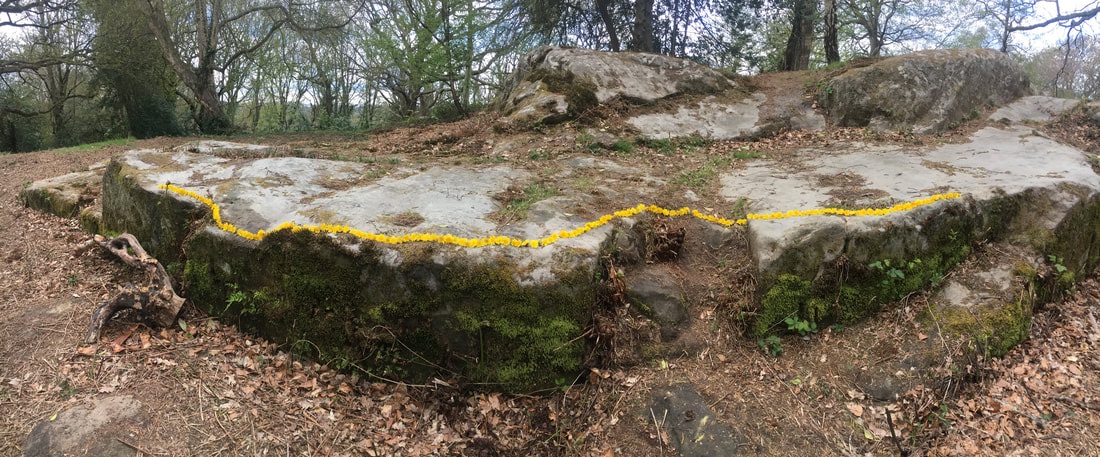
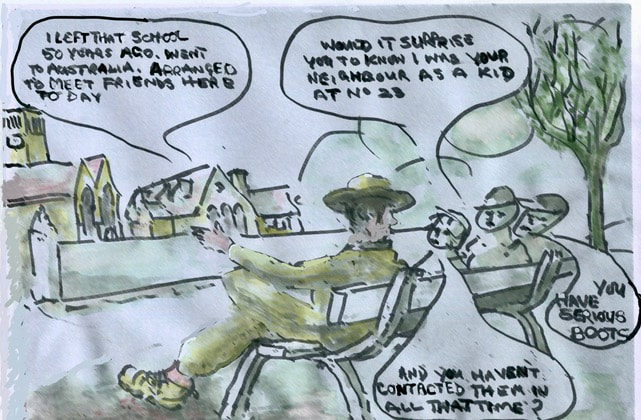
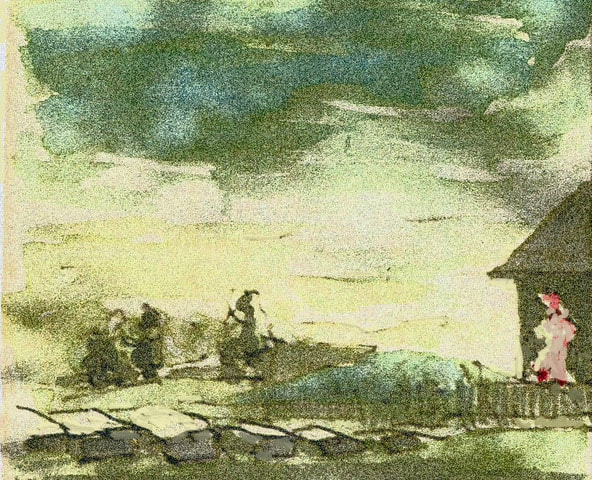
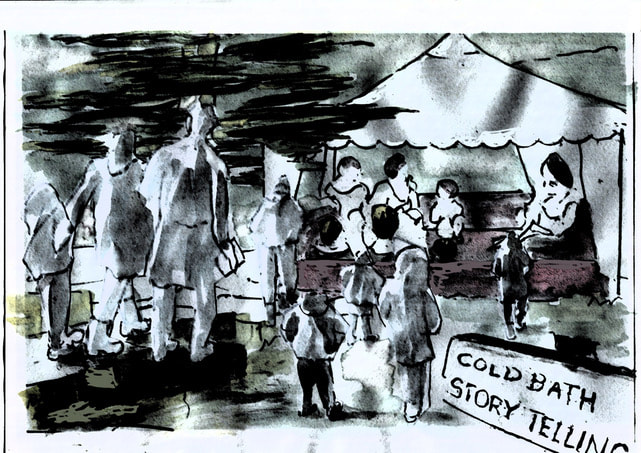
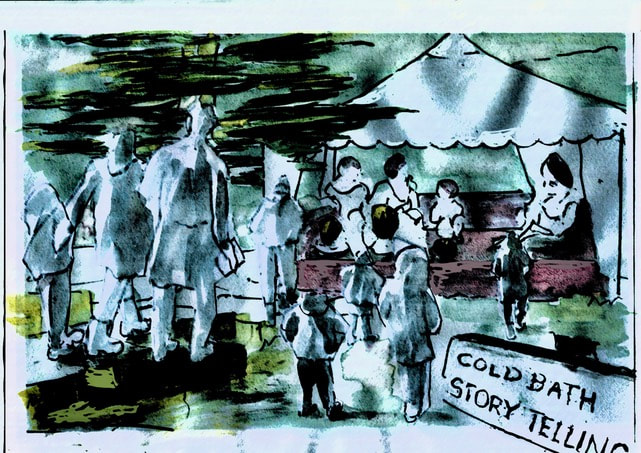
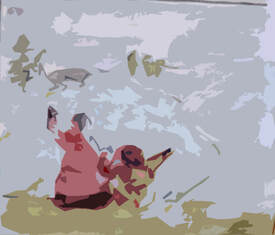
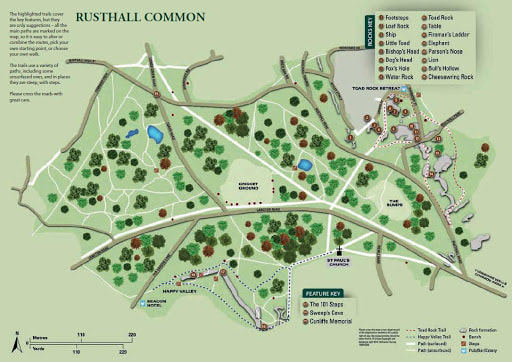
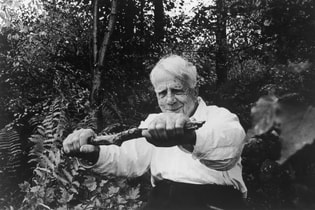
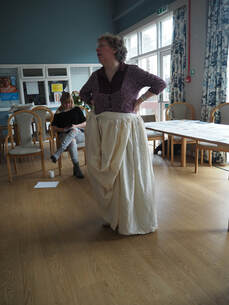
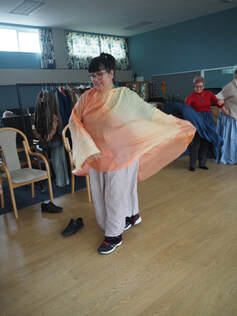
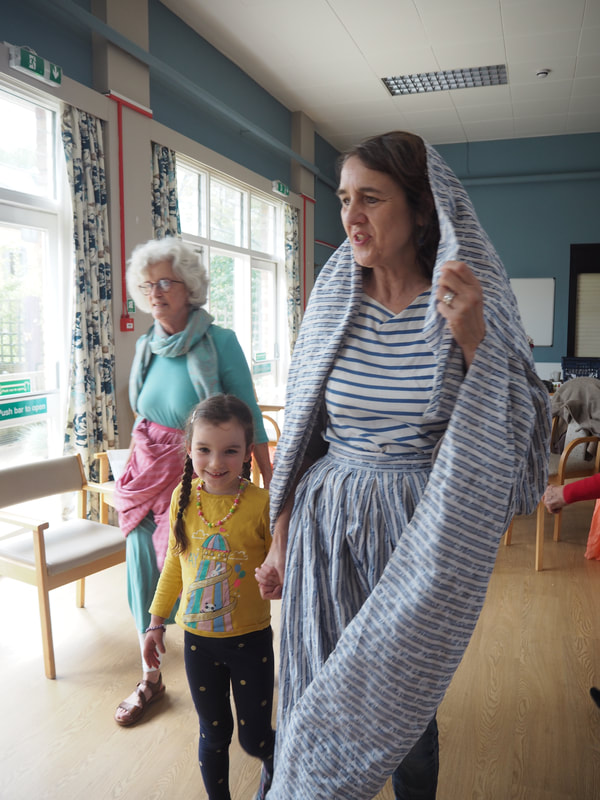
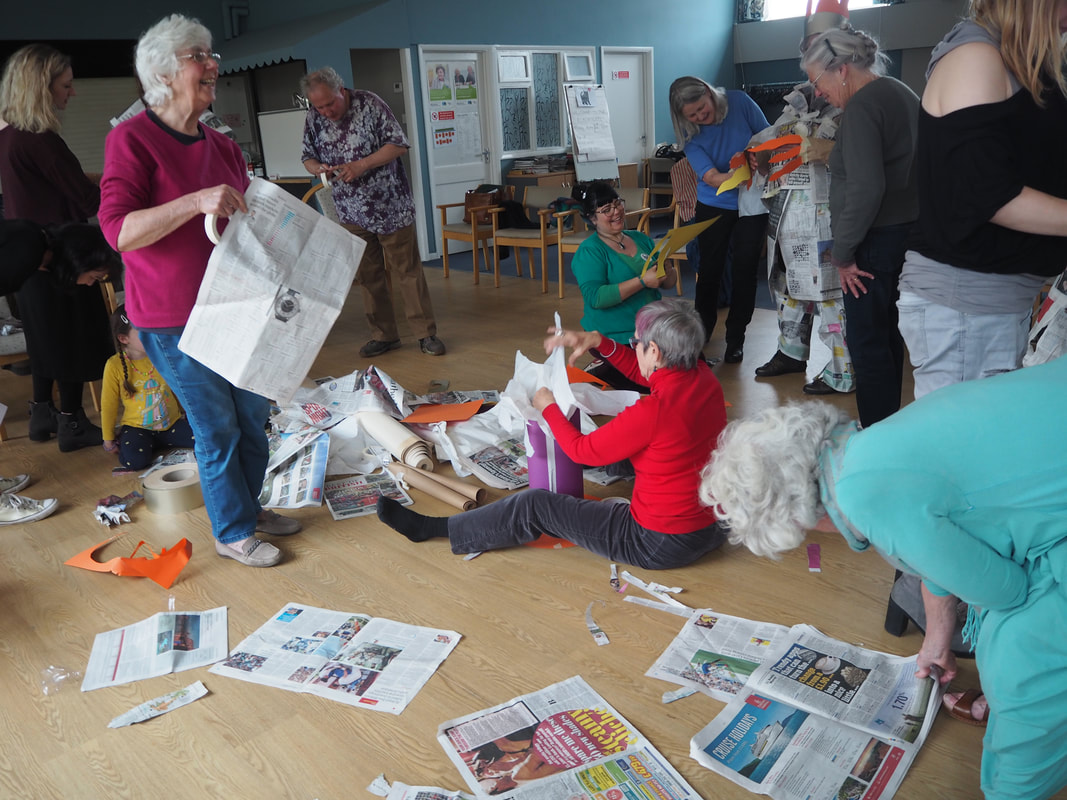
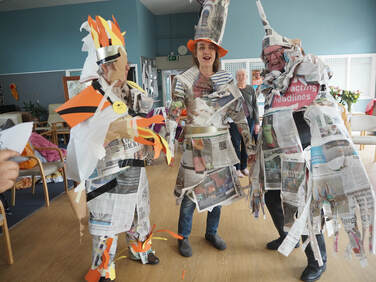
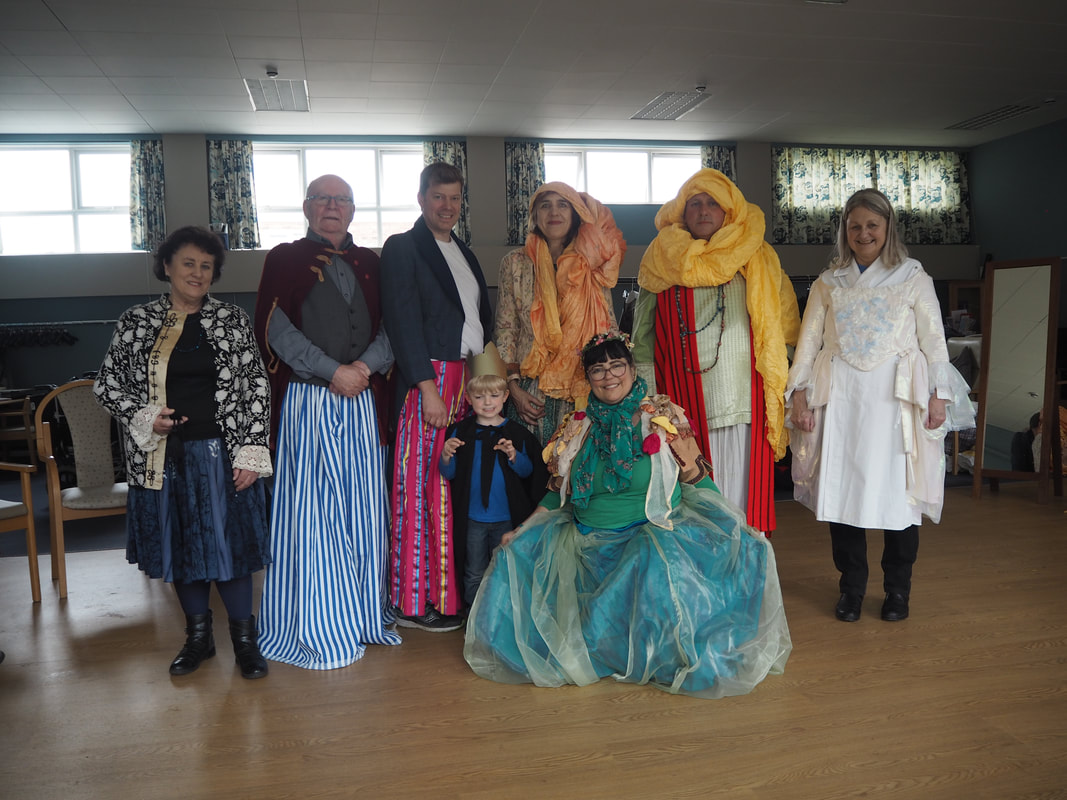
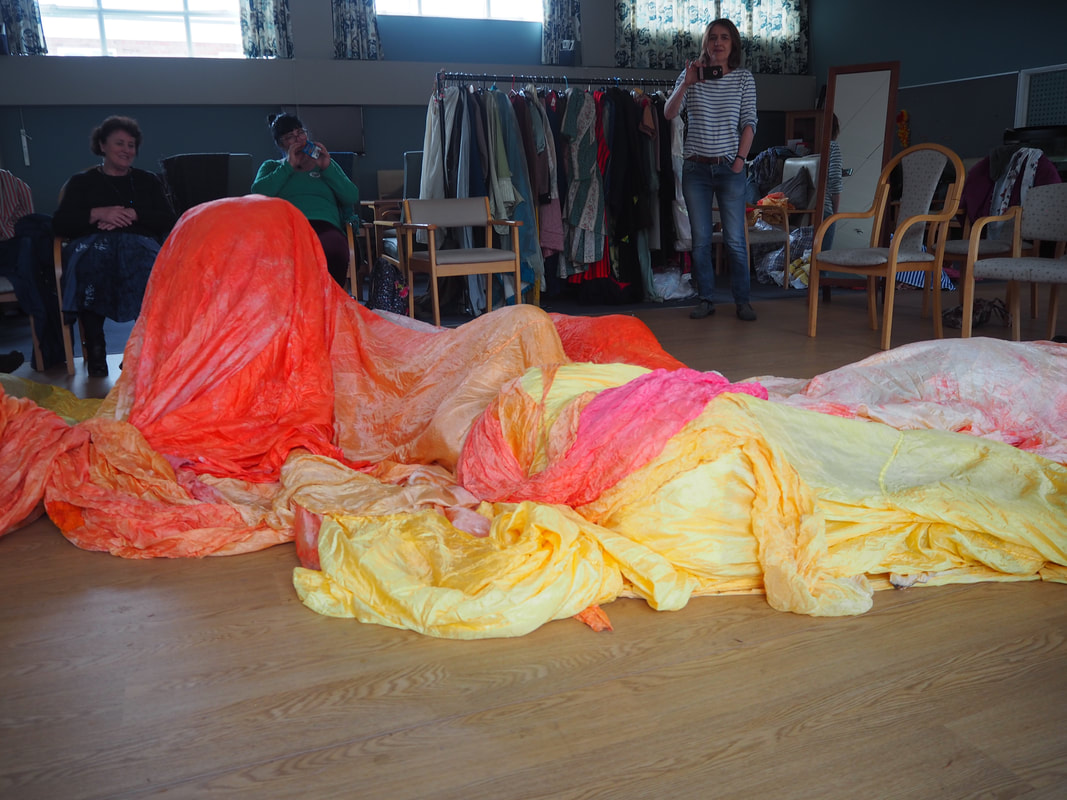
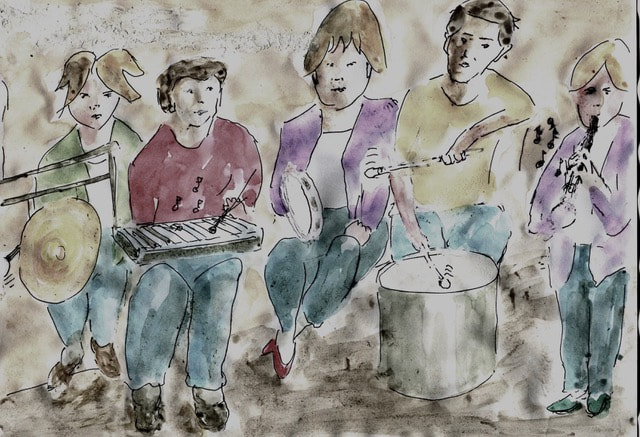
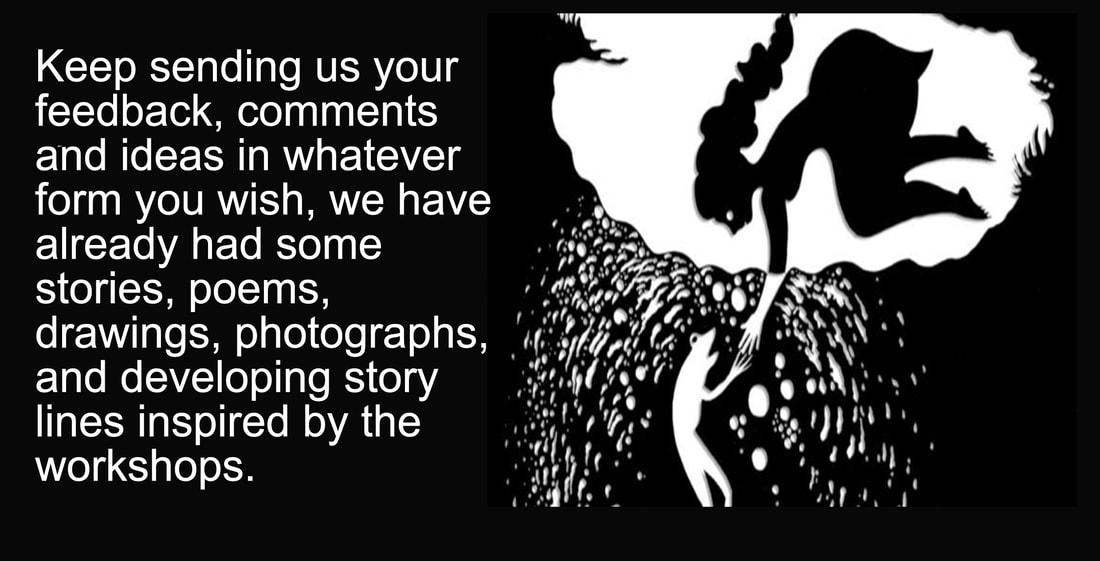
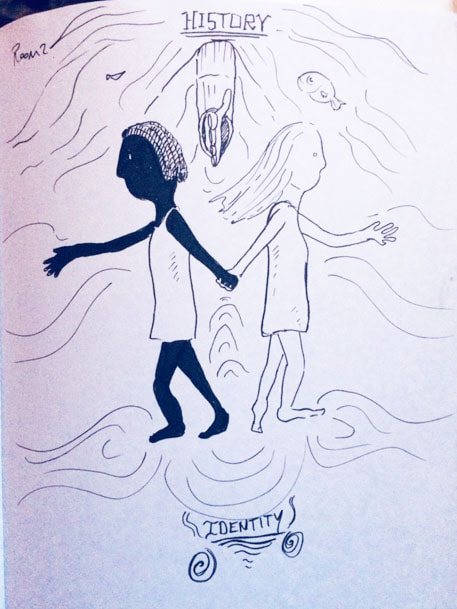
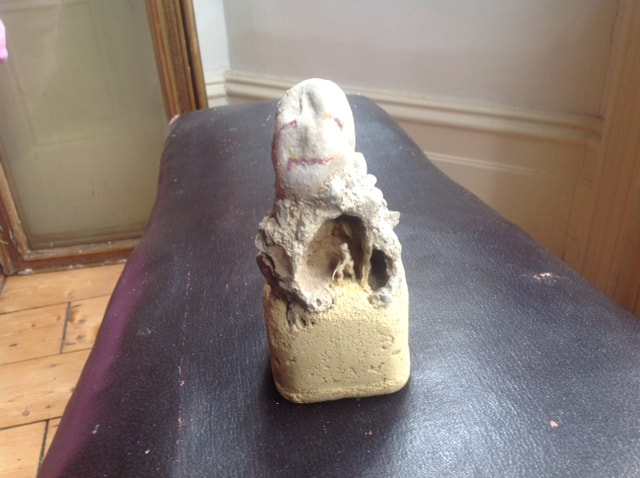
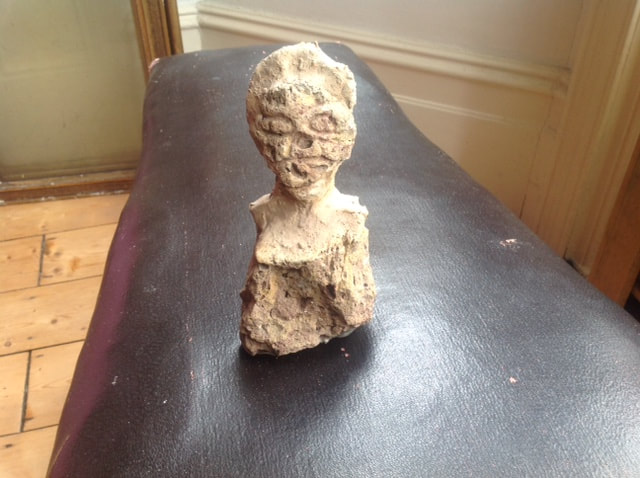



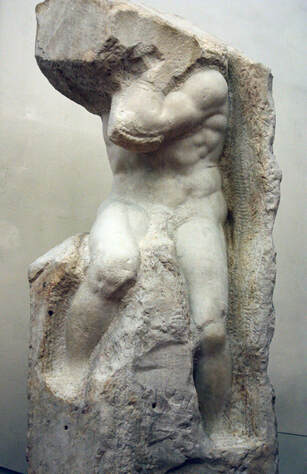

 RSS Feed
RSS Feed